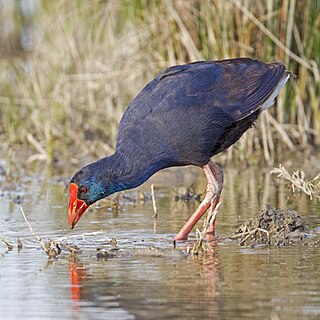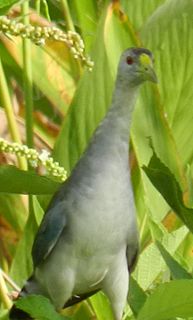
Sub-Saharan Africa is, geographically, the area of the continent of Africa that lies south of the Sahara. Geopolitically, in addition to the African countries and territories that are situated fully in that specified region, the term may also include polities that only have part of their territory located in that region, per the definition of the United Nations (UN). While the UN geoscheme for Africa excludes the northern Sudan from its definition of sub-Saharan Africa, the African Union's regional definition includes it while instead excluding Mauritania.

The western swamphen is a swamphen in the rail family Rallidae, one of the six species of purple swamphen. From the French name talève sultane, it is also known as the sultana bird. This chicken-sized bird, with its large feet, bright plumage and red bill and frontal shield is easily recognisable in its native range. It used to be considered the nominate subspecies of the purple swamphen, but is now recognised as a separate species. The western swamphen is found in wetlands in Spain, Portugal, southeastern France, Italy and northwestern Africa.

Allen's gallinule, formerly known as the lesser gallinule, is a small waterbird of the family Rallidae. Its former binomial name is Porphyrula alleni. Porphyrio is the Latin for "swamphen", and alleni, like the English name, commemorates British naval officer Rear-Admiral William Allen (1792–1864).

The purple gallinule is a swamphen in the genus Porphyrio. It is in the order Gruiformes, meaning "crane-like", an order which also contains cranes, rails, and crakes. The purple gallinule is a rail species, placing it into the family Rallidae. It is also known locally as the yellow-legged gallinule. The specific name martinica denotes "of Martinique".

The white swamphen, also known as the Lord Howe swamphen, Lord Howe gallinule or white gallinule, is an extinct species of rail which lived on Lord Howe Island, east of Australia. It was first encountered when the crews of British ships visited the island between 1788 and 1790, and all contemporary accounts and illustrations were produced during this time. Today, two skins exist: the holotype in the Natural History Museum of Vienna, and another in Liverpool's World Museum. Although historical confusion has existed about the provenance of the specimens and the classification and anatomy of the bird, it is now thought to have been a distinct species endemic to Lord Howe Island and most similar to the Australasian swamphen. Subfossil bones have also been discovered since.

The dusky moorhen is a bird species in the rail family and is one of the eight extant species in the moorhen genus. It occurs in India, Australia, New Guinea, Borneo and Indonesia. It is often confused with the purple swamphen and the Eurasian coot due to similar appearance and overlapping distributions. They often live alongside birds in the same genus, such as the Tasmanian nativehen and the common moorhen.

The red-billed oxpecker is a passerine bird in the oxpecker family, Buphagidae. It is native to the savannah of sub-Saharan Africa, from the Central African Republic east to South Sudan and south to northern and eastern South Africa. Its range overlaps that of the less widespread yellow-billed oxpecker.

Porphyrio is the swamphen or swamp hen bird genus in the rail family. It includes some smaller species which are usually called "purple gallinules", and which are sometimes separated as genus Porphyrula or united with the gallinules proper in Gallinula. The Porphyrio gallinules are distributed in the warmer regions of the world. The group probably originated in Africa in the Middle Miocene, before spreading across the world in waves from the Late Miocene to Pleistocene.

The Réunion swamphen, also known as the Réunion gallinule or oiseau bleu, is a hypothetical extinct species of rail that was endemic to the Mascarene island of Réunion. While only known from 17th and 18th century accounts by visitors to the island, it was scientifically named in 1848, based on the 1674 account by Sieur Dubois. A considerable literature was subsequently devoted to its possible affinities, with current researchers agreeing it was derived from the swamphen genus Porphyrio. It has been considered mysterious and enigmatic due to the lack of any physical evidence of its existence.

The azure gallinule is a species of bird in the family Rallidae. It is found in Argentina, Bolivia, Brazil, Colombia, Ecuador, French Guiana, Guyana, Paraguay, Peru, Suriname, Trinidad and Tobago, and Venezuela.

The cuckoo-finch, also known as the parasitic weaver or cuckoo weaver, is a small passerine bird now placed in the family Viduidae with the indigobirds and whydahs. It occurs in grassland in Africa south of the Sahara. The male is mainly yellow and green while the female is buff with dark streaks. The eggs are laid in the nests of other birds.

The grey cuckooshrike is a species of bird in the cuckooshrike family Campephagidae. It is a medium-sized forest bird, with grey to blue-grey plumage and large black eyes. There are two subspecies that occur in forest patches of southern and central Africa respectively.

The Knysna woodpecker is a species of bird in the family Picidae. It is endemic to South Africa, where its natural habitats are subtropical or tropical moist lowland forests, moist savanna, and subtropical or tropical moist shrubland. It is threatened by habitat loss. It belongs to a species complex that includes the golden-tailed and Mombasa woodpeckers.

The Australasian swamphen is a species of swamphen (Porphyrio) occurring in eastern Indonesia, Papua New Guinea, Australia and New Zealand. In New Zealand, it is known as the pukeko. The species used to be considered a subspecies of the purple swamphen.
The Diep River Fynbos Corridor is a nature reserve located in the Blaauwberg region of Cape Town, South Africa. It forms part of the larger Table Bay Nature Reserve, which was established in June 2012.

The grey-headed swamphen is a species of swamphen occurring from the Middle East and the Indian subcontinent to southern China and northern Thailand. It used to be considered a subspecies of the purple swamphen, but was elevated to full species status in 2015; today the purple swamphen is considered a superspecies and each of its six subspecies groups are designated full species.

The black-backed swamphen is a species of swamphen occurring from southeast Asia to Sulawesi and Borneo. It used to be considered a subspecies of the purple swamphen, which it resembles, but has a large shield, black upperparts, and the side of the head is blackish.
The purple swamphen has been split into the following species:

Crotaphopeltis hotamboeia, commonly known as the herald snake or the red-lipped snake, is a species of snake in the family Colubridae. The species is endemic to Sub-Saharan Africa.


















